Businesses have scorecards to measure their goals against their accomplishments. These scorecards typically deal with several aspects of the business, such as financial performance and customer satisfaction.
Why not do the same in the garden? Of course, the parameters would be quite different. The scorecard could be a simple measure of goals versus accomplishments. With that in mind, here is the 2014 scorecard for Serendipity Gardens.
My Primary 2014 Goal
This year, we had one primary goal, to make Serendipity Gardens even more friendly to wildlife than it already was. To achieve this goal, we planned several activities. Each one is listed below, with a comment and a “grade.”
Yes. We planted 10 natives recently (great blue Lobelia (3 plants), button bush, pearly everlasting, hare bell, prairie drop seed ornamental grass, dotted monarda, large-leaf aster, and thimbleweed. Earlier in the season, we also planted two plants known as “pussy-toes,” two new swamp milkweed (which did not make it), and an elder shrub. A regular milkweed planted itself in the front yard, much to our delight, and two swamp milkweeds came up as well, as though to take the place of the two that did not survive. It will be next year before we know how well these plants do. The biggest change is that, now, unlike past years, we think about the origin of a plant before deciding to use it. Grade: A
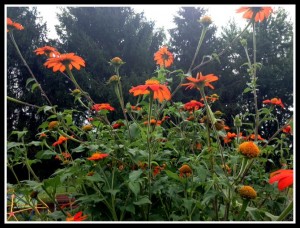 Yes. We purchased a bag of wildflower seeds from John Scheepers Kitchen Garden Seeds. The bag came with directions on how to spread the seeds using sand. We created a method to distribute the seeds evenly using leftover plastic flowerpots. We apparently did not prepare the soil as carefully as we should have. Although the wildflowers came up, so did lots of weeds! We weeded ruthlessly, however, and by the end of the summer, the wildflowers looked quite lovely. The stars were these bright orange blossoms with velvety stems, and several varieties of cosmos. I am hoping to see most of them again next year, thank to self-seeding. Grade: B
Yes. We purchased a bag of wildflower seeds from John Scheepers Kitchen Garden Seeds. The bag came with directions on how to spread the seeds using sand. We created a method to distribute the seeds evenly using leftover plastic flowerpots. We apparently did not prepare the soil as carefully as we should have. Although the wildflowers came up, so did lots of weeds! We weeded ruthlessly, however, and by the end of the summer, the wildflowers looked quite lovely. The stars were these bright orange blossoms with velvety stems, and several varieties of cosmos. I am hoping to see most of them again next year, thank to self-seeding. Grade: B
Yes. We built a bee hotel using a seven-inch log. We bored numerous holes of various widths and mounted the hotel high enough that nothing will grow up to cover the entrance holes. The problem was, we kept postponing this project for one reason or another, so it was late summer before we got it done. As a result, no bees have used it as of yet. I still have hopes for next year, though. We also still need to add a “roof” to protect the holes from rain. Grade: B
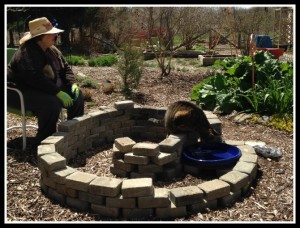 Yes. We built a spiral herb garden using leftover patio bricks. It took less than a day, and the major work was hauling the bricks. We built the garden early in spring, locating it near a favorite swing under a maple tree, so that we could view the new plants and smell them, too. We planted basil, thyme, rosemary, parsley, savory, and oregano, along with a few plants to bloom and add color. The parsley grew most enthusiastically and overwhelmed the savory, but otherwise, all the plants did well. Our cat, Buster, was quite interested in this new structure.
Yes. We built a spiral herb garden using leftover patio bricks. It took less than a day, and the major work was hauling the bricks. We built the garden early in spring, locating it near a favorite swing under a maple tree, so that we could view the new plants and smell them, too. We planted basil, thyme, rosemary, parsley, savory, and oregano, along with a few plants to bloom and add color. The parsley grew most enthusiastically and overwhelmed the savory, but otherwise, all the plants did well. Our cat, Buster, was quite interested in this new structure.
 Learn more about the beneficial insects in Serendipity Gardens
Learn more about the beneficial insects in Serendipity Gardens
Yes. I read Jessica Wallister’s book, Attracting Beneficial Bugs to your Garden, and I paid much more attention to bugs when I saw them. For instance, spotting a red and black bug on the swamp milkweed, I did research and learned that it was a milkweed bug. I also noticed the beauty of some bugs by taking a closer look — and I came across several black and white bees. Not yellow, white. A praying mantis made its presence known as well, which I might have missed in previous years. I have much more to do in this area, however, so I would give myself a grade of B.
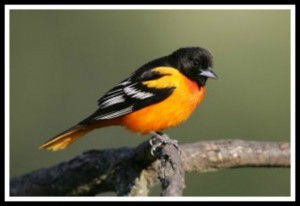 Take new steps to attract more birds
Take new steps to attract more birds
Not so much. Other than plant natives, we did little to attract more birds. We had intended, for example, to purchase an oriole feeder, and we never did. We also never put out any food for any birds whatsoever. We did have the pleasure of welcoming two brown thrashers, who seemed to like the low-growing plants in the front yard. And we have for years provided birds water, food in the form of insects and berries, places to shelter and places to raise young. Grade: C
With all these efforts, we did attract new wildlife: the brown thrashers, the black and white bees, and perhaps a couple of new butterflies and beneficial insects. Plus, we had lots of creatures who were old friends in the garden as well. Overall, I would give us a B+ in this area.
Additional Garden Assessments
- Weeds were bad this year, particularly in a very rainy June. We did not really get ahead of them until September, when the weather cooled. Grade: D
- We did not have any major pest outbreaks. Sawfly larva ate a rose in the early spring, but the rose recovered — just in time for the Japanese beetles. Japanese beetles are the primary pest we have every year — and so far, they’ve pretty much won the battle. Grade: C
- I sowed seeds for several flowers in addition to the wildflowers, with mixed results. Zinnias were great. Nasturtiums were beautiful for awhile, but then, in late summer, they started to look ugly, so we took them out. Nicotiana came up nicely, one plant completely outside of the bed where I sowed it, and they added a lovely touch. Two or three others I tried did not germinate at all. Grade: B
 Our vegetable successes were kale, tomatoes, peas, and potatoes. Cukes, lettuces, carrots and radishes did not do so well. A small yellow watermelon was coming up nicely, when a rabbit decided to eat the seedlings. We enjoyed the veggies we had, though. As always, they tasted better than anything we could buy at the store. Grade: B
Our vegetable successes were kale, tomatoes, peas, and potatoes. Cukes, lettuces, carrots and radishes did not do so well. A small yellow watermelon was coming up nicely, when a rabbit decided to eat the seedlings. We enjoyed the veggies we had, though. As always, they tasted better than anything we could buy at the store. Grade: B- A particular veggie success was my “Grab and Go Tomatoes.” We planted a Sun Gold cherry tomato in a big pot right by the kitchen door. It produced plentifully all summer long, and every time we left or entered the kitchen, we had a one or two. The grandchildren enjoyed them, too. That is one experiment that we will definitely repeat. Grade: A
- We had several family parties on the patio, enjoying the ambiance of the garden. Grade: A
Overall Grade
All in all, 2014 was a mixed bag in Serendipity Gardens. Like in all years, it had some successes and some failures. Despite all that, the garden gave us beauty, food, a place to gather, fresh air, and a sense of doing something important to support wildlife. Keeping these things as well as the more technical aspects of gardening in mind, I’d give us an overall grade of A-. It was well worth the effort!
Have you thought of “grading” your garden? It’s a fun exercise, and gives you a chance to reflect on the year and start the planning process for the year to come.
Like this post? Sign up to receive an email each time a new post is available. We will never loan, sell or rent your email address — that’s a promise! Please use the buttons below to share with others.
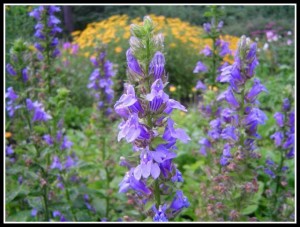
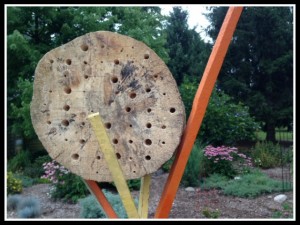
Great use of measurement in the garden,with six sigma tools such as the scorecard.